Urban Regeneration and Displacement
VerifiedAdded on 2020/04/15
|12
|3214
|263
AI Summary
This assignment examines the complex consequences of urban regeneration projects. It delves into the detrimental effects on communities, focusing on displacement, its psychological toll on residents, and the destruction of social and economic infrastructure. The analysis highlights the often-overlooked human costs associated with urban renewal initiatives.
Contribute Materials
Your contribution can guide someone’s learning journey. Share your
documents today.
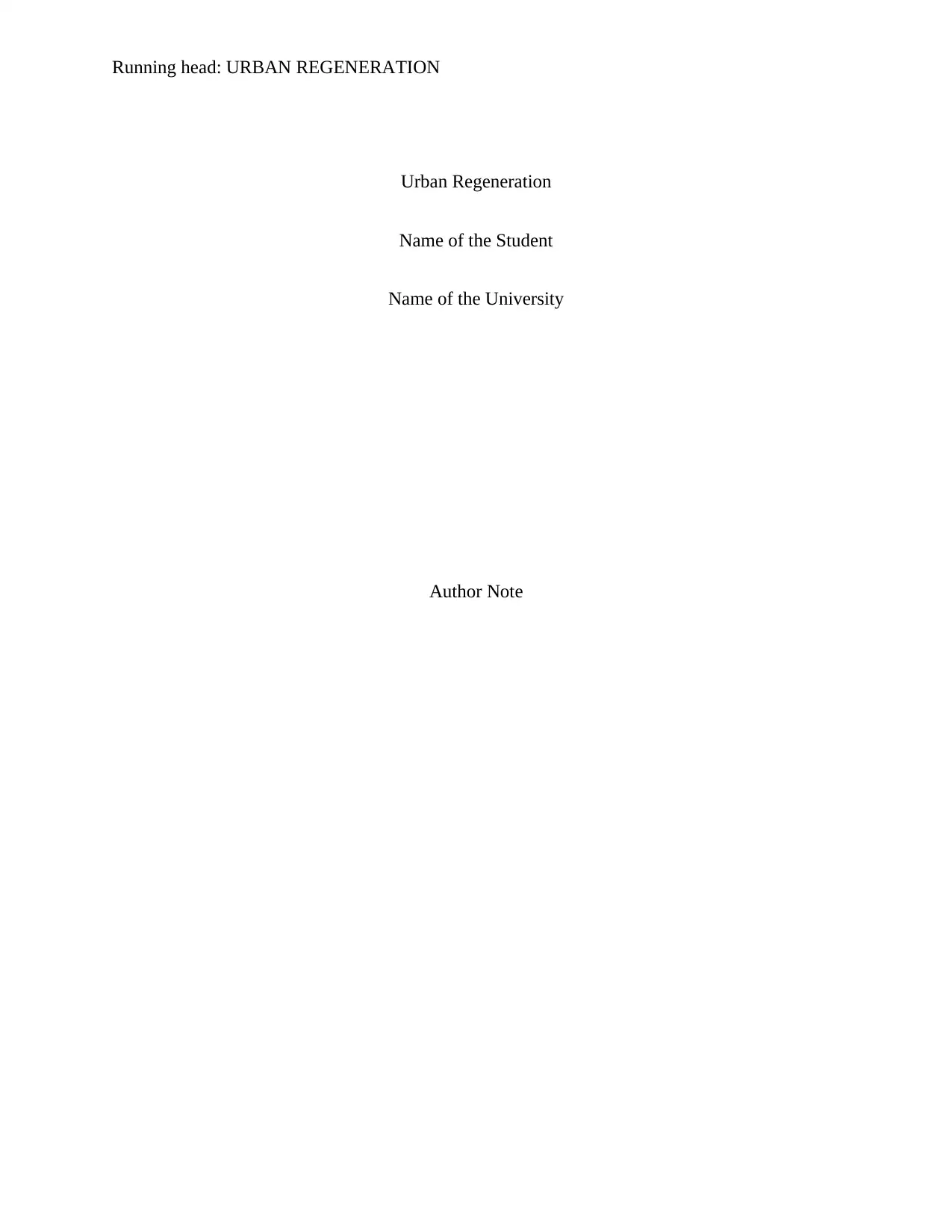
Running head: URBAN REGENERATION
Urban Regeneration
Name of the Student
Name of the University
Author Note
Urban Regeneration
Name of the Student
Name of the University
Author Note
Secure Best Marks with AI Grader
Need help grading? Try our AI Grader for instant feedback on your assignments.
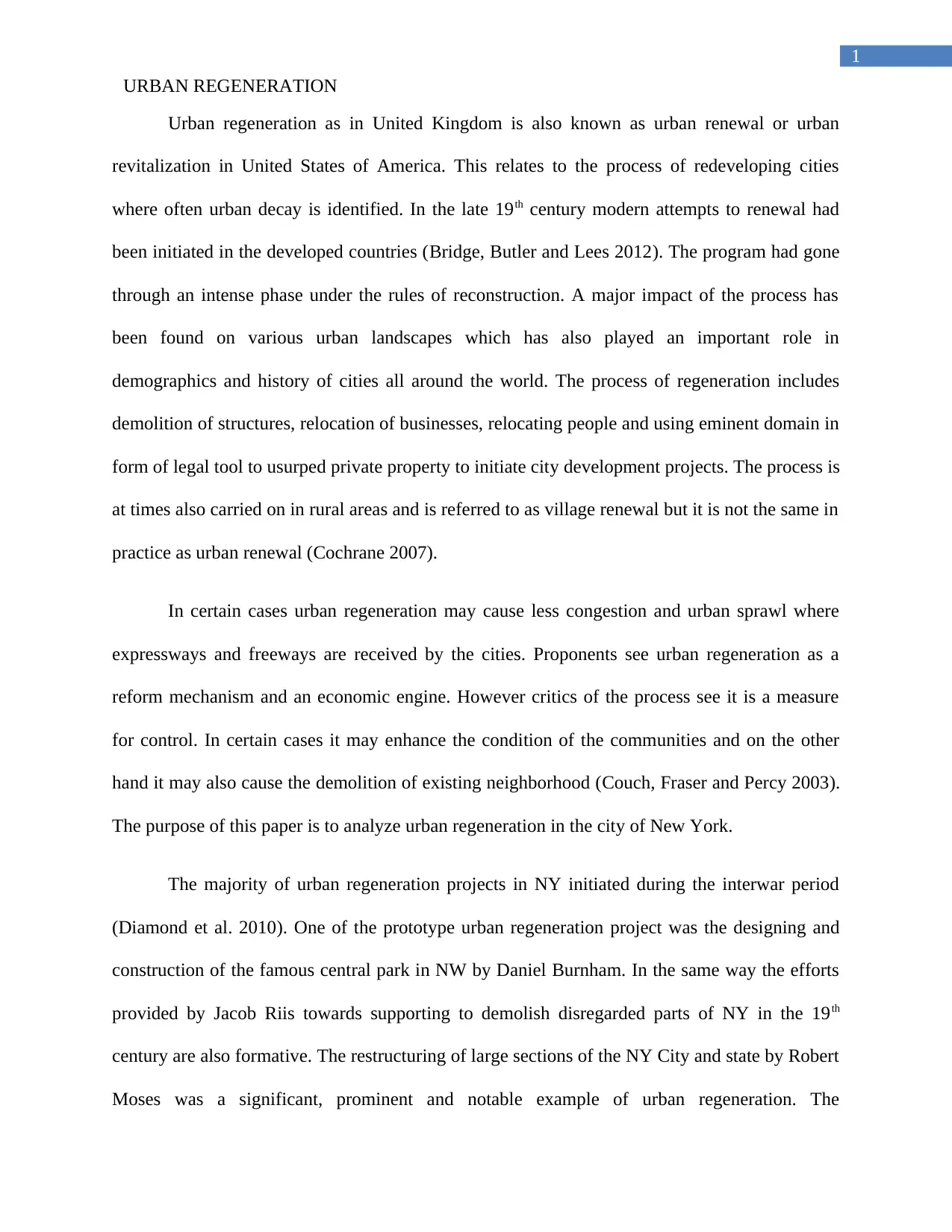
1
URBAN REGENERATION
Urban regeneration as in United Kingdom is also known as urban renewal or urban
revitalization in United States of America. This relates to the process of redeveloping cities
where often urban decay is identified. In the late 19th century modern attempts to renewal had
been initiated in the developed countries (Bridge, Butler and Lees 2012). The program had gone
through an intense phase under the rules of reconstruction. A major impact of the process has
been found on various urban landscapes which has also played an important role in
demographics and history of cities all around the world. The process of regeneration includes
demolition of structures, relocation of businesses, relocating people and using eminent domain in
form of legal tool to usurped private property to initiate city development projects. The process is
at times also carried on in rural areas and is referred to as village renewal but it is not the same in
practice as urban renewal (Cochrane 2007).
In certain cases urban regeneration may cause less congestion and urban sprawl where
expressways and freeways are received by the cities. Proponents see urban regeneration as a
reform mechanism and an economic engine. However critics of the process see it is a measure
for control. In certain cases it may enhance the condition of the communities and on the other
hand it may also cause the demolition of existing neighborhood (Couch, Fraser and Percy 2003).
The purpose of this paper is to analyze urban regeneration in the city of New York.
The majority of urban regeneration projects in NY initiated during the interwar period
(Diamond et al. 2010). One of the prototype urban regeneration project was the designing and
construction of the famous central park in NW by Daniel Burnham. In the same way the efforts
provided by Jacob Riis towards supporting to demolish disregarded parts of NY in the 19th
century are also formative. The restructuring of large sections of the NY City and state by Robert
Moses was a significant, prominent and notable example of urban regeneration. The
URBAN REGENERATION
Urban regeneration as in United Kingdom is also known as urban renewal or urban
revitalization in United States of America. This relates to the process of redeveloping cities
where often urban decay is identified. In the late 19th century modern attempts to renewal had
been initiated in the developed countries (Bridge, Butler and Lees 2012). The program had gone
through an intense phase under the rules of reconstruction. A major impact of the process has
been found on various urban landscapes which has also played an important role in
demographics and history of cities all around the world. The process of regeneration includes
demolition of structures, relocation of businesses, relocating people and using eminent domain in
form of legal tool to usurped private property to initiate city development projects. The process is
at times also carried on in rural areas and is referred to as village renewal but it is not the same in
practice as urban renewal (Cochrane 2007).
In certain cases urban regeneration may cause less congestion and urban sprawl where
expressways and freeways are received by the cities. Proponents see urban regeneration as a
reform mechanism and an economic engine. However critics of the process see it is a measure
for control. In certain cases it may enhance the condition of the communities and on the other
hand it may also cause the demolition of existing neighborhood (Couch, Fraser and Percy 2003).
The purpose of this paper is to analyze urban regeneration in the city of New York.
The majority of urban regeneration projects in NY initiated during the interwar period
(Diamond et al. 2010). One of the prototype urban regeneration project was the designing and
construction of the famous central park in NW by Daniel Burnham. In the same way the efforts
provided by Jacob Riis towards supporting to demolish disregarded parts of NY in the 19th
century are also formative. The restructuring of large sections of the NY City and state by Robert
Moses was a significant, prominent and notable example of urban regeneration. The
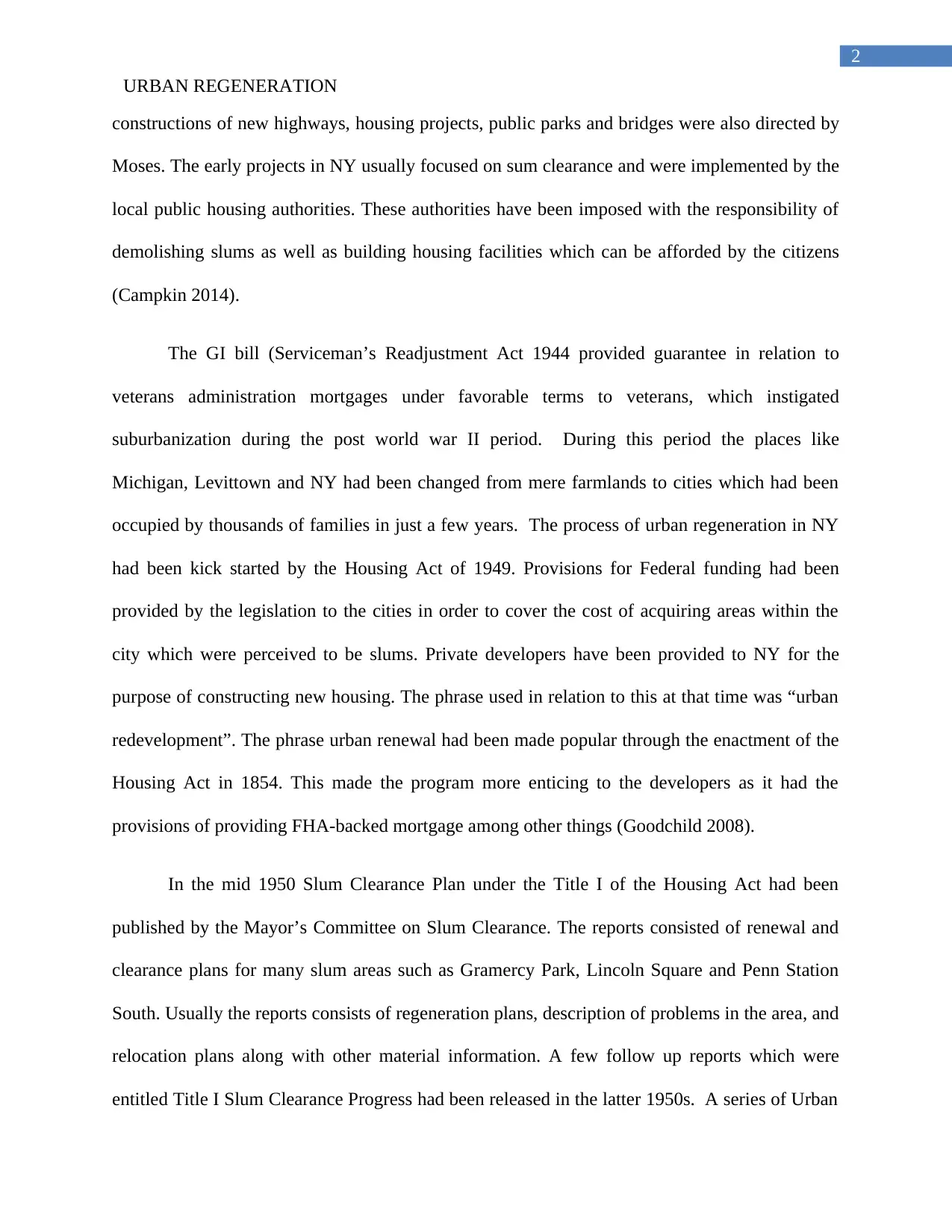
2
URBAN REGENERATION
constructions of new highways, housing projects, public parks and bridges were also directed by
Moses. The early projects in NY usually focused on sum clearance and were implemented by the
local public housing authorities. These authorities have been imposed with the responsibility of
demolishing slums as well as building housing facilities which can be afforded by the citizens
(Campkin 2014).
The GI bill (Serviceman’s Readjustment Act 1944 provided guarantee in relation to
veterans administration mortgages under favorable terms to veterans, which instigated
suburbanization during the post world war II period. During this period the places like
Michigan, Levittown and NY had been changed from mere farmlands to cities which had been
occupied by thousands of families in just a few years. The process of urban regeneration in NY
had been kick started by the Housing Act of 1949. Provisions for Federal funding had been
provided by the legislation to the cities in order to cover the cost of acquiring areas within the
city which were perceived to be slums. Private developers have been provided to NY for the
purpose of constructing new housing. The phrase used in relation to this at that time was “urban
redevelopment”. The phrase urban renewal had been made popular through the enactment of the
Housing Act in 1854. This made the program more enticing to the developers as it had the
provisions of providing FHA-backed mortgage among other things (Goodchild 2008).
In the mid 1950 Slum Clearance Plan under the Title I of the Housing Act had been
published by the Mayor’s Committee on Slum Clearance. The reports consisted of renewal and
clearance plans for many slum areas such as Gramercy Park, Lincoln Square and Penn Station
South. Usually the reports consists of regeneration plans, description of problems in the area, and
relocation plans along with other material information. A few follow up reports which were
entitled Title I Slum Clearance Progress had been released in the latter 1950s. A series of Urban
URBAN REGENERATION
constructions of new highways, housing projects, public parks and bridges were also directed by
Moses. The early projects in NY usually focused on sum clearance and were implemented by the
local public housing authorities. These authorities have been imposed with the responsibility of
demolishing slums as well as building housing facilities which can be afforded by the citizens
(Campkin 2014).
The GI bill (Serviceman’s Readjustment Act 1944 provided guarantee in relation to
veterans administration mortgages under favorable terms to veterans, which instigated
suburbanization during the post world war II period. During this period the places like
Michigan, Levittown and NY had been changed from mere farmlands to cities which had been
occupied by thousands of families in just a few years. The process of urban regeneration in NY
had been kick started by the Housing Act of 1949. Provisions for Federal funding had been
provided by the legislation to the cities in order to cover the cost of acquiring areas within the
city which were perceived to be slums. Private developers have been provided to NY for the
purpose of constructing new housing. The phrase used in relation to this at that time was “urban
redevelopment”. The phrase urban renewal had been made popular through the enactment of the
Housing Act in 1854. This made the program more enticing to the developers as it had the
provisions of providing FHA-backed mortgage among other things (Goodchild 2008).
In the mid 1950 Slum Clearance Plan under the Title I of the Housing Act had been
published by the Mayor’s Committee on Slum Clearance. The reports consisted of renewal and
clearance plans for many slum areas such as Gramercy Park, Lincoln Square and Penn Station
South. Usually the reports consists of regeneration plans, description of problems in the area, and
relocation plans along with other material information. A few follow up reports which were
entitled Title I Slum Clearance Progress had been released in the latter 1950s. A series of Urban
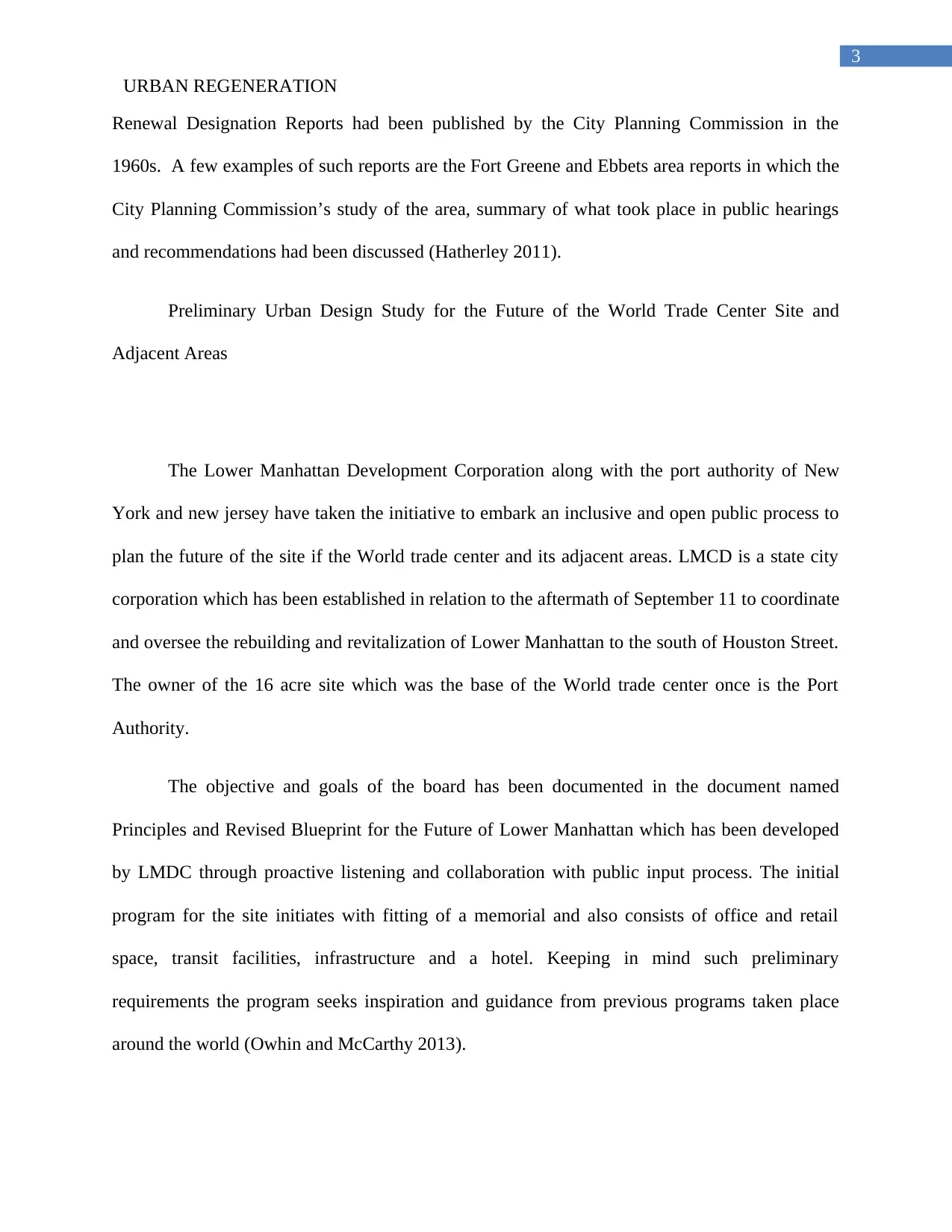
3
URBAN REGENERATION
Renewal Designation Reports had been published by the City Planning Commission in the
1960s. A few examples of such reports are the Fort Greene and Ebbets area reports in which the
City Planning Commission’s study of the area, summary of what took place in public hearings
and recommendations had been discussed (Hatherley 2011).
Preliminary Urban Design Study for the Future of the World Trade Center Site and
Adjacent Areas
The Lower Manhattan Development Corporation along with the port authority of New
York and new jersey have taken the initiative to embark an inclusive and open public process to
plan the future of the site if the World trade center and its adjacent areas. LMCD is a state city
corporation which has been established in relation to the aftermath of September 11 to coordinate
and oversee the rebuilding and revitalization of Lower Manhattan to the south of Houston Street.
The owner of the 16 acre site which was the base of the World trade center once is the Port
Authority.
The objective and goals of the board has been documented in the document named
Principles and Revised Blueprint for the Future of Lower Manhattan which has been developed
by LMDC through proactive listening and collaboration with public input process. The initial
program for the site initiates with fitting of a memorial and also consists of office and retail
space, transit facilities, infrastructure and a hotel. Keeping in mind such preliminary
requirements the program seeks inspiration and guidance from previous programs taken place
around the world (Owhin and McCarthy 2013).
URBAN REGENERATION
Renewal Designation Reports had been published by the City Planning Commission in the
1960s. A few examples of such reports are the Fort Greene and Ebbets area reports in which the
City Planning Commission’s study of the area, summary of what took place in public hearings
and recommendations had been discussed (Hatherley 2011).
Preliminary Urban Design Study for the Future of the World Trade Center Site and
Adjacent Areas
The Lower Manhattan Development Corporation along with the port authority of New
York and new jersey have taken the initiative to embark an inclusive and open public process to
plan the future of the site if the World trade center and its adjacent areas. LMCD is a state city
corporation which has been established in relation to the aftermath of September 11 to coordinate
and oversee the rebuilding and revitalization of Lower Manhattan to the south of Houston Street.
The owner of the 16 acre site which was the base of the World trade center once is the Port
Authority.
The objective and goals of the board has been documented in the document named
Principles and Revised Blueprint for the Future of Lower Manhattan which has been developed
by LMDC through proactive listening and collaboration with public input process. The initial
program for the site initiates with fitting of a memorial and also consists of office and retail
space, transit facilities, infrastructure and a hotel. Keeping in mind such preliminary
requirements the program seeks inspiration and guidance from previous programs taken place
around the world (Owhin and McCarthy 2013).
Secure Best Marks with AI Grader
Need help grading? Try our AI Grader for instant feedback on your assignments.
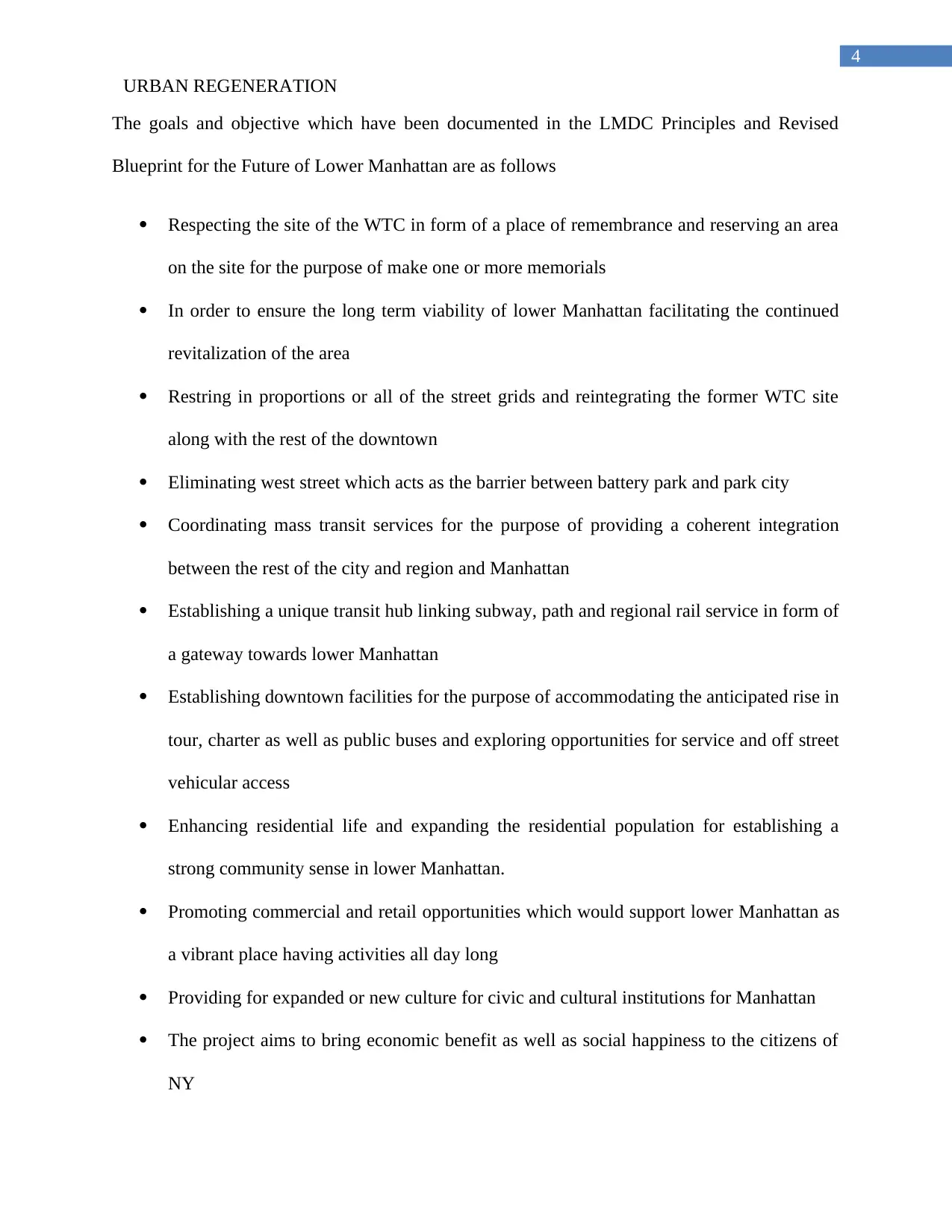
4
URBAN REGENERATION
The goals and objective which have been documented in the LMDC Principles and Revised
Blueprint for the Future of Lower Manhattan are as follows
Respecting the site of the WTC in form of a place of remembrance and reserving an area
on the site for the purpose of make one or more memorials
In order to ensure the long term viability of lower Manhattan facilitating the continued
revitalization of the area
Restring in proportions or all of the street grids and reintegrating the former WTC site
along with the rest of the downtown
Eliminating west street which acts as the barrier between battery park and park city
Coordinating mass transit services for the purpose of providing a coherent integration
between the rest of the city and region and Manhattan
Establishing a unique transit hub linking subway, path and regional rail service in form of
a gateway towards lower Manhattan
Establishing downtown facilities for the purpose of accommodating the anticipated rise in
tour, charter as well as public buses and exploring opportunities for service and off street
vehicular access
Enhancing residential life and expanding the residential population for establishing a
strong community sense in lower Manhattan.
Promoting commercial and retail opportunities which would support lower Manhattan as
a vibrant place having activities all day long
Providing for expanded or new culture for civic and cultural institutions for Manhattan
The project aims to bring economic benefit as well as social happiness to the citizens of
NY
URBAN REGENERATION
The goals and objective which have been documented in the LMDC Principles and Revised
Blueprint for the Future of Lower Manhattan are as follows
Respecting the site of the WTC in form of a place of remembrance and reserving an area
on the site for the purpose of make one or more memorials
In order to ensure the long term viability of lower Manhattan facilitating the continued
revitalization of the area
Restring in proportions or all of the street grids and reintegrating the former WTC site
along with the rest of the downtown
Eliminating west street which acts as the barrier between battery park and park city
Coordinating mass transit services for the purpose of providing a coherent integration
between the rest of the city and region and Manhattan
Establishing a unique transit hub linking subway, path and regional rail service in form of
a gateway towards lower Manhattan
Establishing downtown facilities for the purpose of accommodating the anticipated rise in
tour, charter as well as public buses and exploring opportunities for service and off street
vehicular access
Enhancing residential life and expanding the residential population for establishing a
strong community sense in lower Manhattan.
Promoting commercial and retail opportunities which would support lower Manhattan as
a vibrant place having activities all day long
Providing for expanded or new culture for civic and cultural institutions for Manhattan
The project aims to bring economic benefit as well as social happiness to the citizens of
NY
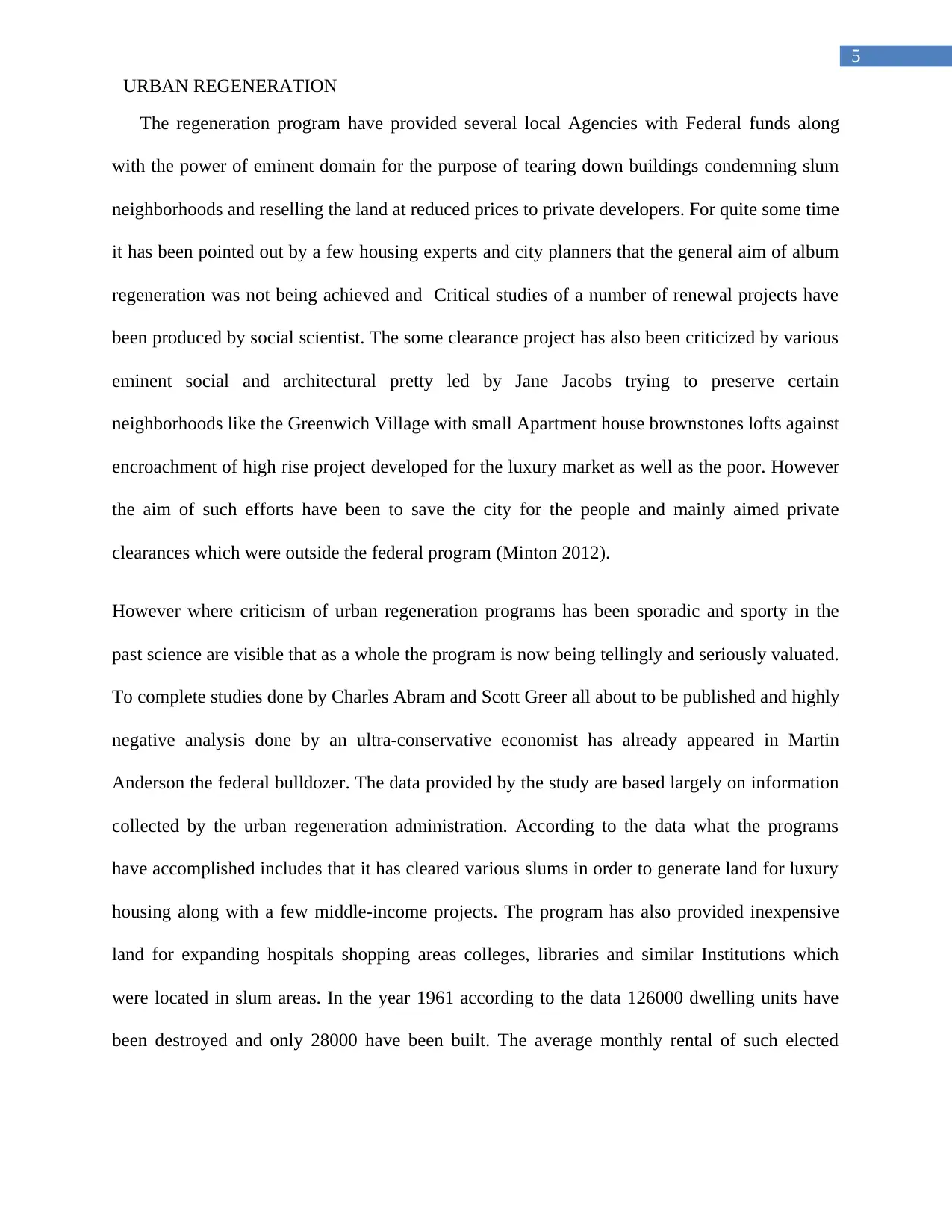
5
URBAN REGENERATION
The regeneration program have provided several local Agencies with Federal funds along
with the power of eminent domain for the purpose of tearing down buildings condemning slum
neighborhoods and reselling the land at reduced prices to private developers. For quite some time
it has been pointed out by a few housing experts and city planners that the general aim of album
regeneration was not being achieved and Critical studies of a number of renewal projects have
been produced by social scientist. The some clearance project has also been criticized by various
eminent social and architectural pretty led by Jane Jacobs trying to preserve certain
neighborhoods like the Greenwich Village with small Apartment house brownstones lofts against
encroachment of high rise project developed for the luxury market as well as the poor. However
the aim of such efforts have been to save the city for the people and mainly aimed private
clearances which were outside the federal program (Minton 2012).
However where criticism of urban regeneration programs has been sporadic and sporty in the
past science are visible that as a whole the program is now being tellingly and seriously valuated.
To complete studies done by Charles Abram and Scott Greer all about to be published and highly
negative analysis done by an ultra-conservative economist has already appeared in Martin
Anderson the federal bulldozer. The data provided by the study are based largely on information
collected by the urban regeneration administration. According to the data what the programs
have accomplished includes that it has cleared various slums in order to generate land for luxury
housing along with a few middle-income projects. The program has also provided inexpensive
land for expanding hospitals shopping areas colleges, libraries and similar Institutions which
were located in slum areas. In the year 1961 according to the data 126000 dwelling units have
been destroyed and only 28000 have been built. The average monthly rental of such elected
URBAN REGENERATION
The regeneration program have provided several local Agencies with Federal funds along
with the power of eminent domain for the purpose of tearing down buildings condemning slum
neighborhoods and reselling the land at reduced prices to private developers. For quite some time
it has been pointed out by a few housing experts and city planners that the general aim of album
regeneration was not being achieved and Critical studies of a number of renewal projects have
been produced by social scientist. The some clearance project has also been criticized by various
eminent social and architectural pretty led by Jane Jacobs trying to preserve certain
neighborhoods like the Greenwich Village with small Apartment house brownstones lofts against
encroachment of high rise project developed for the luxury market as well as the poor. However
the aim of such efforts have been to save the city for the people and mainly aimed private
clearances which were outside the federal program (Minton 2012).
However where criticism of urban regeneration programs has been sporadic and sporty in the
past science are visible that as a whole the program is now being tellingly and seriously valuated.
To complete studies done by Charles Abram and Scott Greer all about to be published and highly
negative analysis done by an ultra-conservative economist has already appeared in Martin
Anderson the federal bulldozer. The data provided by the study are based largely on information
collected by the urban regeneration administration. According to the data what the programs
have accomplished includes that it has cleared various slums in order to generate land for luxury
housing along with a few middle-income projects. The program has also provided inexpensive
land for expanding hospitals shopping areas colleges, libraries and similar Institutions which
were located in slum areas. In the year 1961 according to the data 126000 dwelling units have
been destroyed and only 28000 have been built. The average monthly rental of such elected
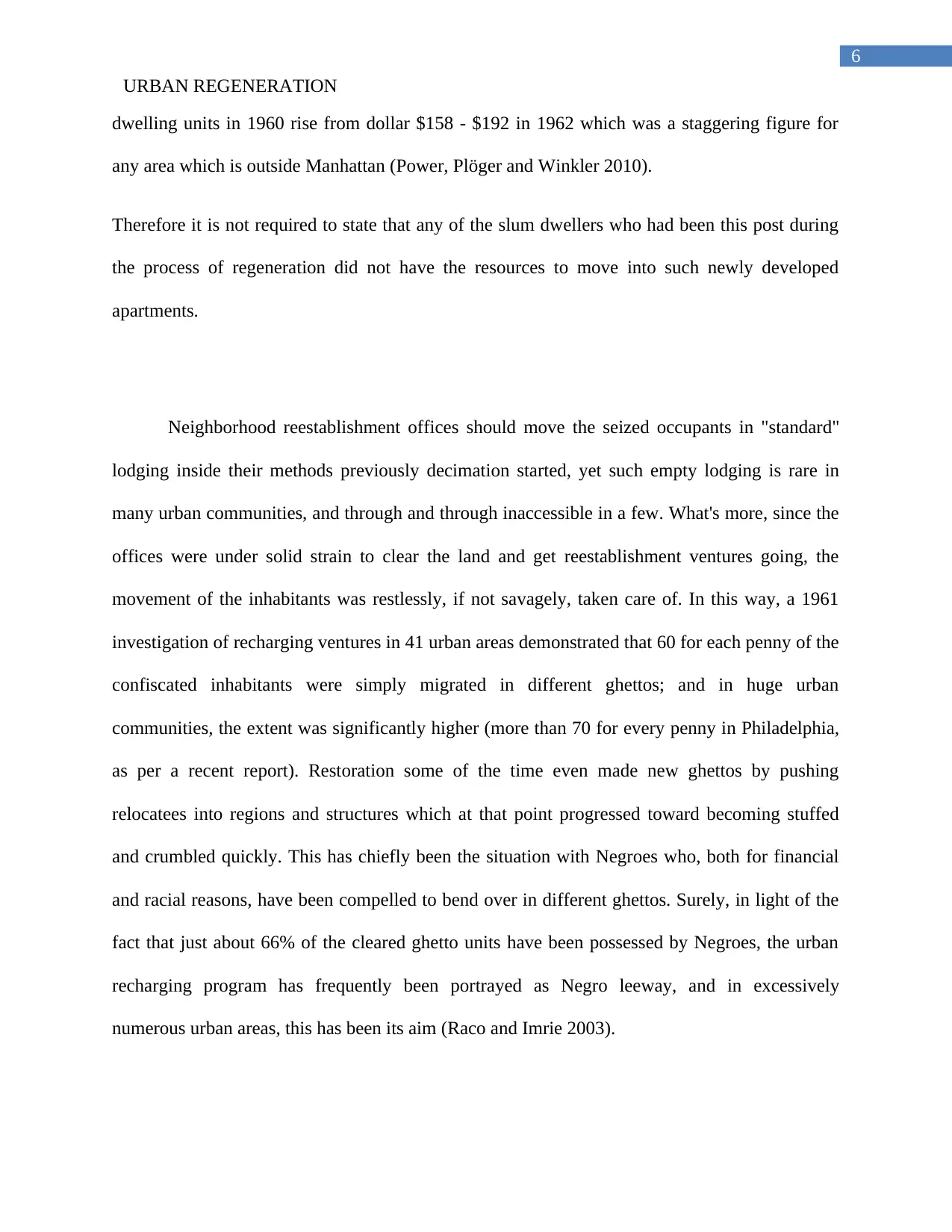
6
URBAN REGENERATION
dwelling units in 1960 rise from dollar $158 - $192 in 1962 which was a staggering figure for
any area which is outside Manhattan (Power, Plöger and Winkler 2010 ).
Therefore it is not required to state that any of the slum dwellers who had been this post during
the process of regeneration did not have the resources to move into such newly developed
apartments.
Neighborhood reestablishment offices should move the seized occupants in "standard"
lodging inside their methods previously decimation started, yet such empty lodging is rare in
many urban communities, and through and through inaccessible in a few. What's more, since the
offices were under solid strain to clear the land and get reestablishment ventures going, the
movement of the inhabitants was restlessly, if not savagely, taken care of. In this way, a 1961
investigation of recharging ventures in 41 urban areas demonstrated that 60 for each penny of the
confiscated inhabitants were simply migrated in different ghettos; and in huge urban
communities, the extent was significantly higher (more than 70 for every penny in Philadelphia,
as per a recent report). Restoration some of the time even made new ghettos by pushing
relocatees into regions and structures which at that point progressed toward becoming stuffed
and crumbled quickly. This has chiefly been the situation with Negroes who, both for financial
and racial reasons, have been compelled to bend over in different ghettos. Surely, in light of the
fact that just about 66% of the cleared ghetto units have been possessed by Negroes, the urban
recharging program has frequently been portrayed as Negro leeway, and in excessively
numerous urban areas, this has been its aim (Raco and Imrie 2003).
URBAN REGENERATION
dwelling units in 1960 rise from dollar $158 - $192 in 1962 which was a staggering figure for
any area which is outside Manhattan (Power, Plöger and Winkler 2010 ).
Therefore it is not required to state that any of the slum dwellers who had been this post during
the process of regeneration did not have the resources to move into such newly developed
apartments.
Neighborhood reestablishment offices should move the seized occupants in "standard"
lodging inside their methods previously decimation started, yet such empty lodging is rare in
many urban communities, and through and through inaccessible in a few. What's more, since the
offices were under solid strain to clear the land and get reestablishment ventures going, the
movement of the inhabitants was restlessly, if not savagely, taken care of. In this way, a 1961
investigation of recharging ventures in 41 urban areas demonstrated that 60 for each penny of the
confiscated inhabitants were simply migrated in different ghettos; and in huge urban
communities, the extent was significantly higher (more than 70 for every penny in Philadelphia,
as per a recent report). Restoration some of the time even made new ghettos by pushing
relocatees into regions and structures which at that point progressed toward becoming stuffed
and crumbled quickly. This has chiefly been the situation with Negroes who, both for financial
and racial reasons, have been compelled to bend over in different ghettos. Surely, in light of the
fact that just about 66% of the cleared ghetto units have been possessed by Negroes, the urban
recharging program has frequently been portrayed as Negro leeway, and in excessively
numerous urban areas, this has been its aim (Raco and Imrie 2003).
Paraphrase This Document
Need a fresh take? Get an instant paraphrase of this document with our AI Paraphraser
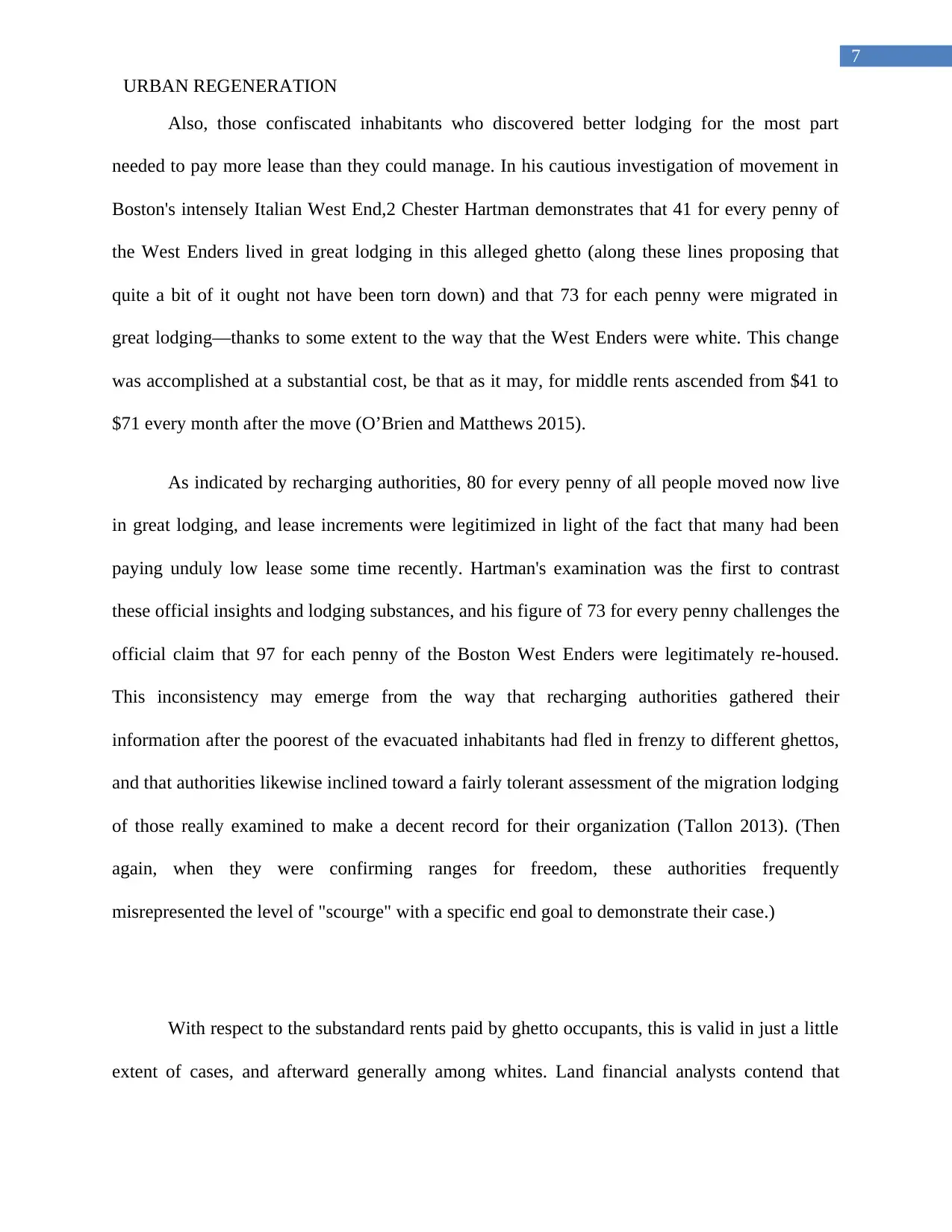
7
URBAN REGENERATION
Also, those confiscated inhabitants who discovered better lodging for the most part
needed to pay more lease than they could manage. In his cautious investigation of movement in
Boston's intensely Italian West End,2 Chester Hartman demonstrates that 41 for every penny of
the West Enders lived in great lodging in this alleged ghetto (along these lines proposing that
quite a bit of it ought not have been torn down) and that 73 for each penny were migrated in
great lodging—thanks to some extent to the way that the West Enders were white. This change
was accomplished at a substantial cost, be that as it may, for middle rents ascended from $41 to
$71 every month after the move (O’Brien and Matthews 2015).
As indicated by recharging authorities, 80 for every penny of all people moved now live
in great lodging, and lease increments were legitimized in light of the fact that many had been
paying unduly low lease some time recently. Hartman's examination was the first to contrast
these official insights and lodging substances, and his figure of 73 for every penny challenges the
official claim that 97 for each penny of the Boston West Enders were legitimately re-housed.
This inconsistency may emerge from the way that recharging authorities gathered their
information after the poorest of the evacuated inhabitants had fled in frenzy to different ghettos,
and that authorities likewise inclined toward a fairly tolerant assessment of the migration lodging
of those really examined to make a decent record for their organization (Tallon 2013). (Then
again, when they were confirming ranges for freedom, these authorities frequently
misrepresented the level of "scourge" with a specific end goal to demonstrate their case.)
With respect to the substandard rents paid by ghetto occupants, this is valid in just a little
extent of cases, and afterward generally among whites. Land financial analysts contend that
URBAN REGENERATION
Also, those confiscated inhabitants who discovered better lodging for the most part
needed to pay more lease than they could manage. In his cautious investigation of movement in
Boston's intensely Italian West End,2 Chester Hartman demonstrates that 41 for every penny of
the West Enders lived in great lodging in this alleged ghetto (along these lines proposing that
quite a bit of it ought not have been torn down) and that 73 for each penny were migrated in
great lodging—thanks to some extent to the way that the West Enders were white. This change
was accomplished at a substantial cost, be that as it may, for middle rents ascended from $41 to
$71 every month after the move (O’Brien and Matthews 2015).
As indicated by recharging authorities, 80 for every penny of all people moved now live
in great lodging, and lease increments were legitimized in light of the fact that many had been
paying unduly low lease some time recently. Hartman's examination was the first to contrast
these official insights and lodging substances, and his figure of 73 for every penny challenges the
official claim that 97 for each penny of the Boston West Enders were legitimately re-housed.
This inconsistency may emerge from the way that recharging authorities gathered their
information after the poorest of the evacuated inhabitants had fled in frenzy to different ghettos,
and that authorities likewise inclined toward a fairly tolerant assessment of the migration lodging
of those really examined to make a decent record for their organization (Tallon 2013). (Then
again, when they were confirming ranges for freedom, these authorities frequently
misrepresented the level of "scourge" with a specific end goal to demonstrate their case.)
With respect to the substandard rents paid by ghetto occupants, this is valid in just a little
extent of cases, and afterward generally among whites. Land financial analysts contend that
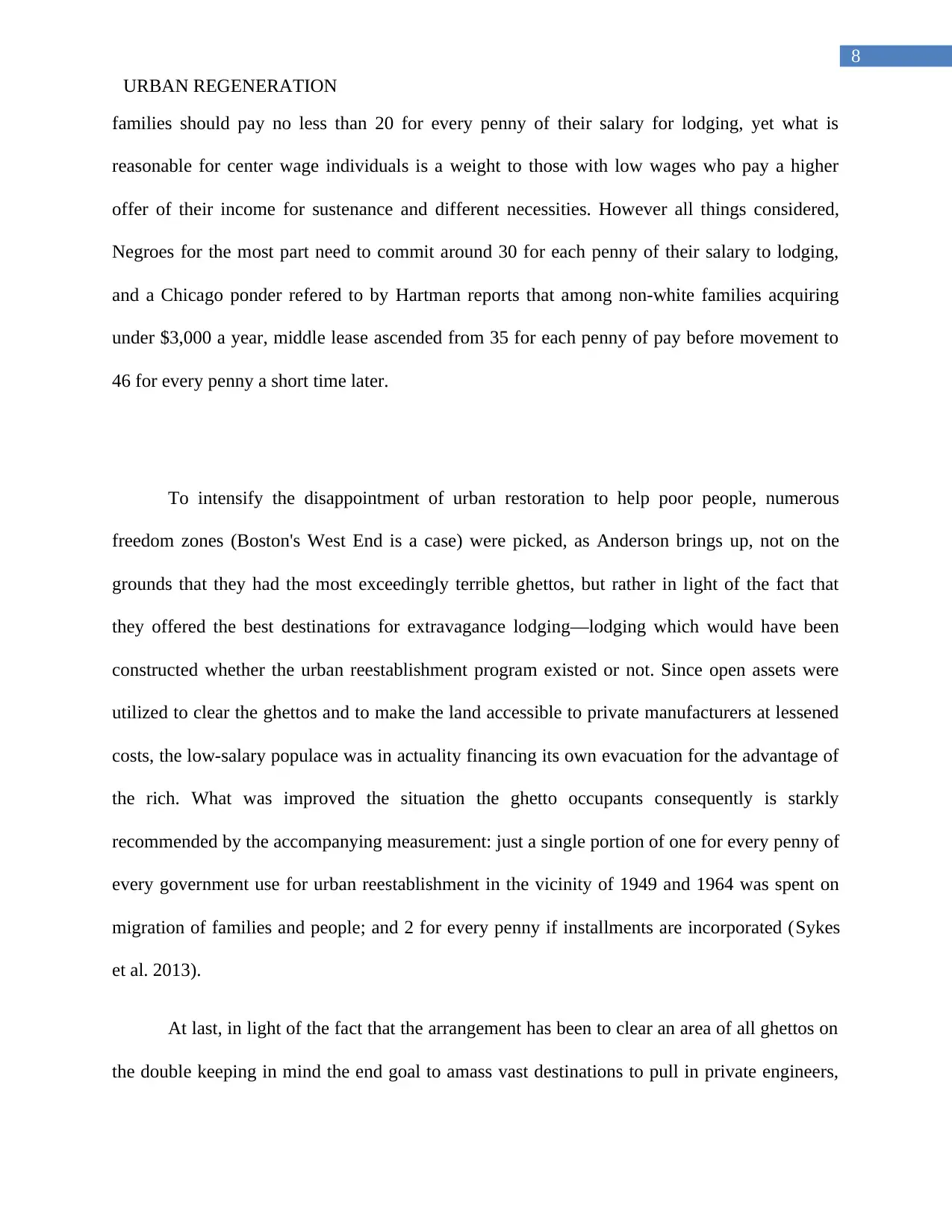
8
URBAN REGENERATION
families should pay no less than 20 for every penny of their salary for lodging, yet what is
reasonable for center wage individuals is a weight to those with low wages who pay a higher
offer of their income for sustenance and different necessities. However all things considered,
Negroes for the most part need to commit around 30 for each penny of their salary to lodging,
and a Chicago ponder refered to by Hartman reports that among non-white families acquiring
under $3,000 a year, middle lease ascended from 35 for each penny of pay before movement to
46 for every penny a short time later.
To intensify the disappointment of urban restoration to help poor people, numerous
freedom zones (Boston's West End is a case) were picked, as Anderson brings up, not on the
grounds that they had the most exceedingly terrible ghettos, but rather in light of the fact that
they offered the best destinations for extravagance lodging—lodging which would have been
constructed whether the urban reestablishment program existed or not. Since open assets were
utilized to clear the ghettos and to make the land accessible to private manufacturers at lessened
costs, the low-salary populace was in actuality financing its own evacuation for the advantage of
the rich. What was improved the situation the ghetto occupants consequently is starkly
recommended by the accompanying measurement: just a single portion of one for every penny of
every government use for urban reestablishment in the vicinity of 1949 and 1964 was spent on
migration of families and people; and 2 for every penny if installments are incorporated (Sykes
et al. 2013).
At last, in light of the fact that the arrangement has been to clear an area of all ghettos on
the double keeping in mind the end goal to amass vast destinations to pull in private engineers,
URBAN REGENERATION
families should pay no less than 20 for every penny of their salary for lodging, yet what is
reasonable for center wage individuals is a weight to those with low wages who pay a higher
offer of their income for sustenance and different necessities. However all things considered,
Negroes for the most part need to commit around 30 for each penny of their salary to lodging,
and a Chicago ponder refered to by Hartman reports that among non-white families acquiring
under $3,000 a year, middle lease ascended from 35 for each penny of pay before movement to
46 for every penny a short time later.
To intensify the disappointment of urban restoration to help poor people, numerous
freedom zones (Boston's West End is a case) were picked, as Anderson brings up, not on the
grounds that they had the most exceedingly terrible ghettos, but rather in light of the fact that
they offered the best destinations for extravagance lodging—lodging which would have been
constructed whether the urban reestablishment program existed or not. Since open assets were
utilized to clear the ghettos and to make the land accessible to private manufacturers at lessened
costs, the low-salary populace was in actuality financing its own evacuation for the advantage of
the rich. What was improved the situation the ghetto occupants consequently is starkly
recommended by the accompanying measurement: just a single portion of one for every penny of
every government use for urban reestablishment in the vicinity of 1949 and 1964 was spent on
migration of families and people; and 2 for every penny if installments are incorporated (Sykes
et al. 2013).
At last, in light of the fact that the arrangement has been to clear an area of all ghettos on
the double keeping in mind the end goal to amass vast destinations to pull in private engineers,
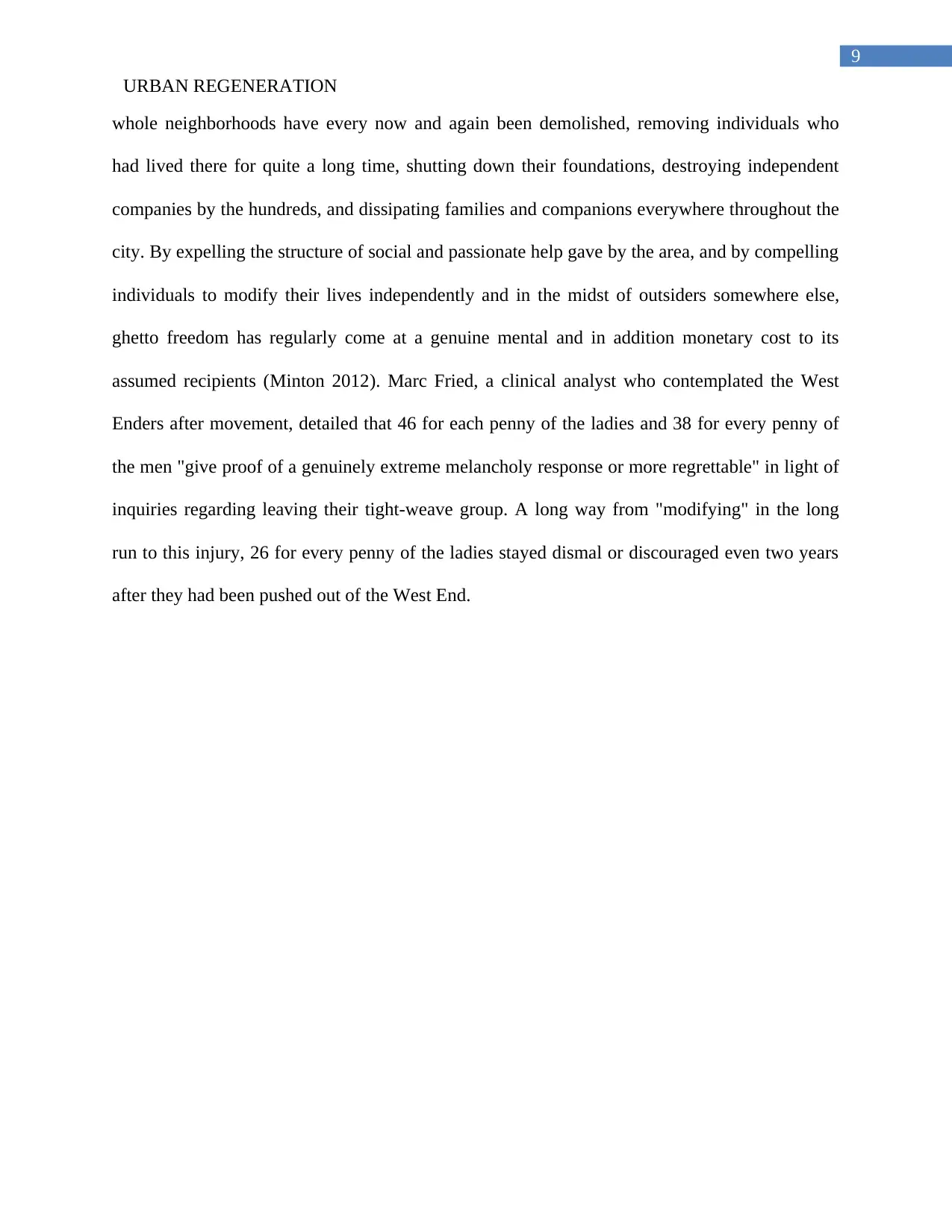
9
URBAN REGENERATION
whole neighborhoods have every now and again been demolished, removing individuals who
had lived there for quite a long time, shutting down their foundations, destroying independent
companies by the hundreds, and dissipating families and companions everywhere throughout the
city. By expelling the structure of social and passionate help gave by the area, and by compelling
individuals to modify their lives independently and in the midst of outsiders somewhere else,
ghetto freedom has regularly come at a genuine mental and in addition monetary cost to its
assumed recipients (Minton 2012). Marc Fried, a clinical analyst who contemplated the West
Enders after movement, detailed that 46 for each penny of the ladies and 38 for every penny of
the men "give proof of a genuinely extreme melancholy response or more regrettable" in light of
inquiries regarding leaving their tight-weave group. A long way from "modifying" in the long
run to this injury, 26 for every penny of the ladies stayed dismal or discouraged even two years
after they had been pushed out of the West End.
URBAN REGENERATION
whole neighborhoods have every now and again been demolished, removing individuals who
had lived there for quite a long time, shutting down their foundations, destroying independent
companies by the hundreds, and dissipating families and companions everywhere throughout the
city. By expelling the structure of social and passionate help gave by the area, and by compelling
individuals to modify their lives independently and in the midst of outsiders somewhere else,
ghetto freedom has regularly come at a genuine mental and in addition monetary cost to its
assumed recipients (Minton 2012). Marc Fried, a clinical analyst who contemplated the West
Enders after movement, detailed that 46 for each penny of the ladies and 38 for every penny of
the men "give proof of a genuinely extreme melancholy response or more regrettable" in light of
inquiries regarding leaving their tight-weave group. A long way from "modifying" in the long
run to this injury, 26 for every penny of the ladies stayed dismal or discouraged even two years
after they had been pushed out of the West End.
Secure Best Marks with AI Grader
Need help grading? Try our AI Grader for instant feedback on your assignments.
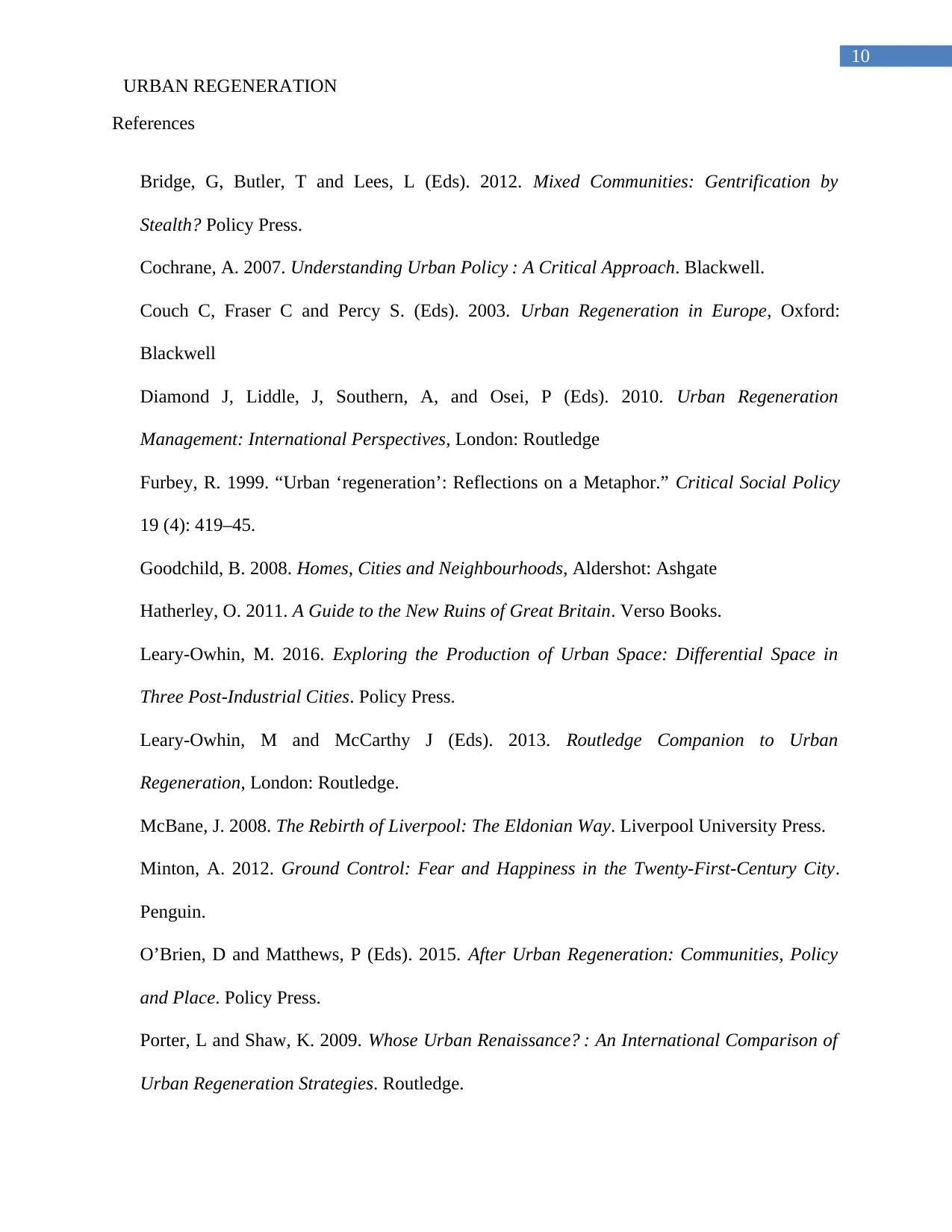
10
URBAN REGENERATION
References
Bridge, G, Butler, T and Lees, L (Eds). 2012. Mixed Communities: Gentrification by
Stealth? Policy Press.
Cochrane, A. 2007. Understanding Urban Policy : A Critical Approach. Blackwell.
Couch C, Fraser C and Percy S. (Eds). 2003. Urban Regeneration in Europe, Oxford:
Blackwell
Diamond J, Liddle, J, Southern, A, and Osei, P (Eds). 2010. Urban Regeneration
Management: International Perspectives, London: Routledge
Furbey, R. 1999. “Urban ‘regeneration’: Reflections on a Metaphor.” Critical Social Policy
19 (4): 419–45.
Goodchild, B. 2008. Homes, Cities and Neighbourhoods, Aldershot: Ashgate
Hatherley, O. 2011. A Guide to the New Ruins of Great Britain. Verso Books.
Leary-Owhin, M. 2016. Exploring the Production of Urban Space: Differential Space in
Three Post-Industrial Cities. Policy Press.
Leary-Owhin, M and McCarthy J (Eds). 2013. Routledge Companion to Urban
Regeneration, London: Routledge.
McBane, J. 2008. The Rebirth of Liverpool: The Eldonian Way. Liverpool University Press.
Minton, A. 2012. Ground Control: Fear and Happiness in the Twenty-First-Century City.
Penguin.
O’Brien, D and Matthews, P (Eds). 2015. After Urban Regeneration: Communities, Policy
and Place. Policy Press.
Porter, L and Shaw, K. 2009. Whose Urban Renaissance? : An International Comparison of
Urban Regeneration Strategies. Routledge.
URBAN REGENERATION
References
Bridge, G, Butler, T and Lees, L (Eds). 2012. Mixed Communities: Gentrification by
Stealth? Policy Press.
Cochrane, A. 2007. Understanding Urban Policy : A Critical Approach. Blackwell.
Couch C, Fraser C and Percy S. (Eds). 2003. Urban Regeneration in Europe, Oxford:
Blackwell
Diamond J, Liddle, J, Southern, A, and Osei, P (Eds). 2010. Urban Regeneration
Management: International Perspectives, London: Routledge
Furbey, R. 1999. “Urban ‘regeneration’: Reflections on a Metaphor.” Critical Social Policy
19 (4): 419–45.
Goodchild, B. 2008. Homes, Cities and Neighbourhoods, Aldershot: Ashgate
Hatherley, O. 2011. A Guide to the New Ruins of Great Britain. Verso Books.
Leary-Owhin, M. 2016. Exploring the Production of Urban Space: Differential Space in
Three Post-Industrial Cities. Policy Press.
Leary-Owhin, M and McCarthy J (Eds). 2013. Routledge Companion to Urban
Regeneration, London: Routledge.
McBane, J. 2008. The Rebirth of Liverpool: The Eldonian Way. Liverpool University Press.
Minton, A. 2012. Ground Control: Fear and Happiness in the Twenty-First-Century City.
Penguin.
O’Brien, D and Matthews, P (Eds). 2015. After Urban Regeneration: Communities, Policy
and Place. Policy Press.
Porter, L and Shaw, K. 2009. Whose Urban Renaissance? : An International Comparison of
Urban Regeneration Strategies. Routledge.
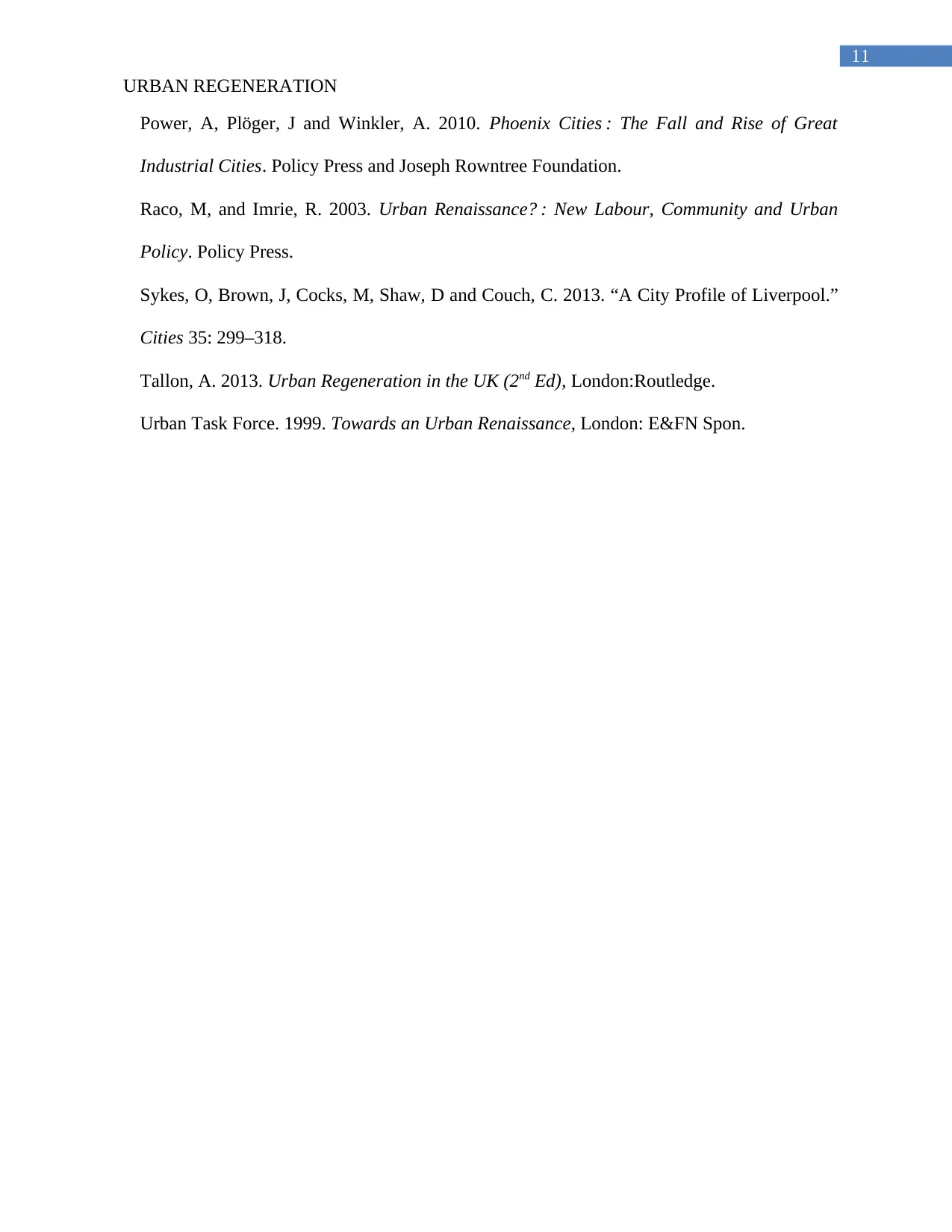
11
URBAN REGENERATION
Power, A, Plöger, J and Winkler, A. 2010. Phoenix Cities : The Fall and Rise of Great
Industrial Cities. Policy Press and Joseph Rowntree Foundation.
Raco, M, and Imrie, R. 2003. Urban Renaissance? : New Labour, Community and Urban
Policy. Policy Press.
Sykes, O, Brown, J, Cocks, M, Shaw, D and Couch, C. 2013. “A City Profile of Liverpool.”
Cities 35: 299–318.
Tallon, A. 2013. Urban Regeneration in the UK (2nd Ed), London:Routledge.
Urban Task Force. 1999. Towards an Urban Renaissance, London: E&FN Spon.
URBAN REGENERATION
Power, A, Plöger, J and Winkler, A. 2010. Phoenix Cities : The Fall and Rise of Great
Industrial Cities. Policy Press and Joseph Rowntree Foundation.
Raco, M, and Imrie, R. 2003. Urban Renaissance? : New Labour, Community and Urban
Policy. Policy Press.
Sykes, O, Brown, J, Cocks, M, Shaw, D and Couch, C. 2013. “A City Profile of Liverpool.”
Cities 35: 299–318.
Tallon, A. 2013. Urban Regeneration in the UK (2nd Ed), London:Routledge.
Urban Task Force. 1999. Towards an Urban Renaissance, London: E&FN Spon.
1 out of 12
Your All-in-One AI-Powered Toolkit for Academic Success.
+13062052269
info@desklib.com
Available 24*7 on WhatsApp / Email
![[object Object]](/_next/static/media/star-bottom.7253800d.svg)
Unlock your academic potential
© 2024 | Zucol Services PVT LTD | All rights reserved.

